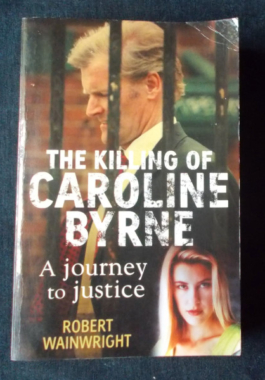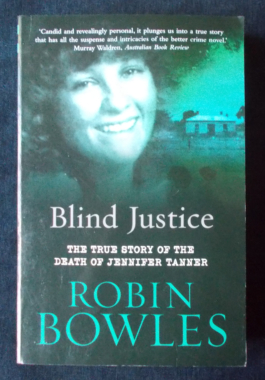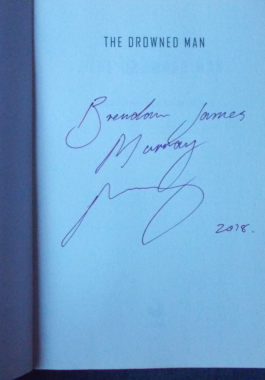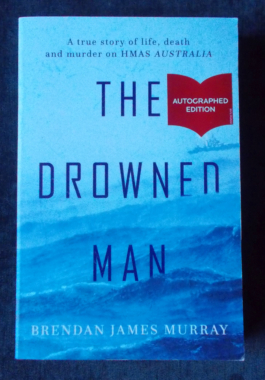-
 It can take years for love to turn to murderous hate - or it can happen overnight. What drives a woman or man to committ the ultimate betrayal - to take the life of a parent, a child, a sibling, a lover? This is a volume of unflicnhing exploration of fourteen well-known - and not so well-known - murder in the family cases and it takes the reader inside the life and mind of both the killer and victim. The cases include: The slaying of Maureen Thompson by her husband Rory; the murders of the four Folbigg children by their mother Kathleen; the sudden explosion of murderous rage within Sef Gonzales that resulted in the destruction of those closest to him; and more. Illustrated with black and white and colour photographs.
It can take years for love to turn to murderous hate - or it can happen overnight. What drives a woman or man to committ the ultimate betrayal - to take the life of a parent, a child, a sibling, a lover? This is a volume of unflicnhing exploration of fourteen well-known - and not so well-known - murder in the family cases and it takes the reader inside the life and mind of both the killer and victim. The cases include: The slaying of Maureen Thompson by her husband Rory; the murders of the four Folbigg children by their mother Kathleen; the sudden explosion of murderous rage within Sef Gonzales that resulted in the destruction of those closest to him; and more. Illustrated with black and white and colour photographs. -
 Joseph Mengele, the camp doctor at Auschwitz, was personally responsible for the murder of nearly 400,000 people and for the torture of thousands more as part of his 'scientific' experiments. Yet he evaded capture for 40 years and it is only after the discovery of his body in a Brazilian cemetery, that his full story could be told. This investigative biography traces Mengele's roots and examines the forces that made him into a mass murderer and torturer; follows Mengele the fugitive after his flight from Auschwitz and looks at the conspiracy in Germany and Latin America that saved Mengele from justice. This is not only an exposé of Mengele as the very embodiment of evil and the system that spawned him; it is also an explanation of the many 'ordinary' people who shielded and sustained the monster to the grave and beyond. Illustrated with black and white photos.
Joseph Mengele, the camp doctor at Auschwitz, was personally responsible for the murder of nearly 400,000 people and for the torture of thousands more as part of his 'scientific' experiments. Yet he evaded capture for 40 years and it is only after the discovery of his body in a Brazilian cemetery, that his full story could be told. This investigative biography traces Mengele's roots and examines the forces that made him into a mass murderer and torturer; follows Mengele the fugitive after his flight from Auschwitz and looks at the conspiracy in Germany and Latin America that saved Mengele from justice. This is not only an exposé of Mengele as the very embodiment of evil and the system that spawned him; it is also an explanation of the many 'ordinary' people who shielded and sustained the monster to the grave and beyond. Illustrated with black and white photos. -
 On a bleak, moonless winter night in 1995 beautiful Sydney model Caroline Byrne died, her body embedded head-first into a crevice at the bottom of The Gap at the entrance to Sydney Harbor. How did she get out so far, almost 12 meters from the base of the sheer sandstone precipice? Did she jump, as so many had done before at the notorious suicide spot, or had she been thrown in a fit of rage? What began as a sad ritual of retrieving the shattered bodies of shattered lives turned into one of the nation's most extraordinary murder investigations, leading to the dark heart of a city gripped by greed, pandering to its powerful and exposing a police force whose lack of imagination and resources was surpassed only by the doggedness of its finest officers to right an unforgivable wrong. this is a journey to justice: the astonishing inside story of Caroline's father Tony Byrne's determination to find the truth of his daughter's death and in doing so, test the justice system to its limits.
On a bleak, moonless winter night in 1995 beautiful Sydney model Caroline Byrne died, her body embedded head-first into a crevice at the bottom of The Gap at the entrance to Sydney Harbor. How did she get out so far, almost 12 meters from the base of the sheer sandstone precipice? Did she jump, as so many had done before at the notorious suicide spot, or had she been thrown in a fit of rage? What began as a sad ritual of retrieving the shattered bodies of shattered lives turned into one of the nation's most extraordinary murder investigations, leading to the dark heart of a city gripped by greed, pandering to its powerful and exposing a police force whose lack of imagination and resources was surpassed only by the doggedness of its finest officers to right an unforgivable wrong. this is a journey to justice: the astonishing inside story of Caroline's father Tony Byrne's determination to find the truth of his daughter's death and in doing so, test the justice system to its limits. -
 Discover surprising answers in this true-crime treasury of 100 of the most fascinating cases of all time. More than two centuries in the development of modern forensic procedures come to vivid life as everything from handwriting analyses and voiceprints to ballistics, DNA testing and psychological profiles reveal who did it - and, in some startling cases, who didn't do it. Categories: Ballistics; Cause Of Death; Disputed Documents; DNA Typing; Explosives And Fire; Fingerprinting; Forensic Anthropology; Odontology; Psychological Profiling; Identification Of Remains; Serology; Time Of Death; Trace Evidence; Voice Printing. The cases detailed herein range from the 189os to the 1990s. Illustrated with black and white photographs.
Discover surprising answers in this true-crime treasury of 100 of the most fascinating cases of all time. More than two centuries in the development of modern forensic procedures come to vivid life as everything from handwriting analyses and voiceprints to ballistics, DNA testing and psychological profiles reveal who did it - and, in some startling cases, who didn't do it. Categories: Ballistics; Cause Of Death; Disputed Documents; DNA Typing; Explosives And Fire; Fingerprinting; Forensic Anthropology; Odontology; Psychological Profiling; Identification Of Remains; Serology; Time Of Death; Trace Evidence; Voice Printing. The cases detailed herein range from the 189os to the 1990s. Illustrated with black and white photographs. -
 On December 10, 2003 an intruder waits inside the home of Kent and Tricia Whitaker. They and their two sons, Bart and Kevin, are returning from a dinner celebrating Bart's college graduation. Four shots ring out: Tricia and Kevin are killed instantly, Kent is wounded and Bart. struggling with the gunman, is also wounded. Three days later, as investigators explore leads in the search for justice for the victims, they find Bart had been leading a double life and he becomes the chief suspect. Kent believes the police are allowing the real killer to escape while they focus on Bart but when Bart disappears in the mountains of Mexico seven months later, Kent must face the possibility his son was involved in the murder. Fifteen months later, Bart is arrested and charged with masterminding the shootings; in March 2007, he is convicted and sentenced to death. How can a father survive the anguish of his son's actions and forgive such betrayal?
On December 10, 2003 an intruder waits inside the home of Kent and Tricia Whitaker. They and their two sons, Bart and Kevin, are returning from a dinner celebrating Bart's college graduation. Four shots ring out: Tricia and Kevin are killed instantly, Kent is wounded and Bart. struggling with the gunman, is also wounded. Three days later, as investigators explore leads in the search for justice for the victims, they find Bart had been leading a double life and he becomes the chief suspect. Kent believes the police are allowing the real killer to escape while they focus on Bart but when Bart disappears in the mountains of Mexico seven months later, Kent must face the possibility his son was involved in the murder. Fifteen months later, Bart is arrested and charged with masterminding the shootings; in March 2007, he is convicted and sentenced to death. How can a father survive the anguish of his son's actions and forgive such betrayal? -
 On April 4th, 1968, Dr. Martin Luther King, Jr. stepped out onto the balcony of the Lorraine Motel in Memphis, Tennessee, and into his killer's line of fire. One shot ended Dr. King's life and forever changed the course of American history - setting into motion a massive cover-up that has withstood a quarter-century of scrutiny. Now, after 18 years of intensive investigation, William F. Pepper tears away the veil of subterfuge that has hidden the truth of King's death - proving the innocence of convicted assassin James Earl Rayand revealing the cabal of government leaders and organised crime figures that masterminded the assassination of one of the most influential leaders of our age. The author was an associate of Dr. King and executive director of the independent political coalition that hoped to put King forward as a third party presidential candidate in 1968. After the murder, Pepper walked away from politics. But in 1977. Reverend Ralph Abernathy asked Pepper to interview James Earl Ray. Initially sceptical, Pepper became convinced that Ray was innocent of the crime and that Ray had always claimed, he had been manipulated by a man named Raul and was the victim of a set-up. But who was behind the set-up - and why?
On April 4th, 1968, Dr. Martin Luther King, Jr. stepped out onto the balcony of the Lorraine Motel in Memphis, Tennessee, and into his killer's line of fire. One shot ended Dr. King's life and forever changed the course of American history - setting into motion a massive cover-up that has withstood a quarter-century of scrutiny. Now, after 18 years of intensive investigation, William F. Pepper tears away the veil of subterfuge that has hidden the truth of King's death - proving the innocence of convicted assassin James Earl Rayand revealing the cabal of government leaders and organised crime figures that masterminded the assassination of one of the most influential leaders of our age. The author was an associate of Dr. King and executive director of the independent political coalition that hoped to put King forward as a third party presidential candidate in 1968. After the murder, Pepper walked away from politics. But in 1977. Reverend Ralph Abernathy asked Pepper to interview James Earl Ray. Initially sceptical, Pepper became convinced that Ray was innocent of the crime and that Ray had always claimed, he had been manipulated by a man named Raul and was the victim of a set-up. But who was behind the set-up - and why? -
 October, 2011: At first it looked like a swag, said the grader driver who found the body just off the road outside the outback town of Katherine. Police identify the dead man as Ray Nicefero, who'd recently appeared in court for aggravated assault and breaching a domestic violence order. Three days later, three young local suspects were arrested: Christopher Malyschko; Darren 'Spider' Halfpenny; and 19-year-old indigenous Zak Grieve. A month later, Bronwyn Buttery, Ray's former partner and Christopher's mother, is arrested. But when the accused face court in the rough justice system of the Northern Territory, it soon becomes apparent there are few certain, provable facts to be had. Depending on who was talking, a loving friend could be an abusive monster; a battered wife a conniving temptress. And a joke between mates about the best way to dispose of a body becomes a conspiracy to murder. The outcome of the case is no less murky, thanks to the NT's mandatory sentencing laws, which, the judge said, 'brings about injustice'. This is the story of murder in an outback town and the extraordinary aftermath; and it raises important questions such as how an indigenous man who was not present at a murder can be sentenced to jail for twenty years.
October, 2011: At first it looked like a swag, said the grader driver who found the body just off the road outside the outback town of Katherine. Police identify the dead man as Ray Nicefero, who'd recently appeared in court for aggravated assault and breaching a domestic violence order. Three days later, three young local suspects were arrested: Christopher Malyschko; Darren 'Spider' Halfpenny; and 19-year-old indigenous Zak Grieve. A month later, Bronwyn Buttery, Ray's former partner and Christopher's mother, is arrested. But when the accused face court in the rough justice system of the Northern Territory, it soon becomes apparent there are few certain, provable facts to be had. Depending on who was talking, a loving friend could be an abusive monster; a battered wife a conniving temptress. And a joke between mates about the best way to dispose of a body becomes a conspiracy to murder. The outcome of the case is no less murky, thanks to the NT's mandatory sentencing laws, which, the judge said, 'brings about injustice'. This is the story of murder in an outback town and the extraordinary aftermath; and it raises important questions such as how an indigenous man who was not present at a murder can be sentenced to jail for twenty years.






